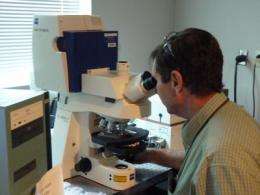SRNL works to decrease hazards from mold in water damaged homes

A team of microbiologists at the U.S. Department of Energy's Savannah River National Laboratory (SRNL) is working with Tuskegee University and Mississippi State University to decrease mold growth in flooded homes through improved prevention and cleanup.
Funded by the Department of Homeland Security (DHS) through the Southeast Regional Research Institute (SERRI), Mississippi State University asked SRNL and Tuskegee University to join the "Effective Mold and Contaminant Remediation for Flood and Water Damaged Homes" project.
"SRNL's Environmental Biotechnology Section has a long history of successfully working with the assessment and cleanup of mold and fungi at the Savannah River Site. In recent years major disasters including hurricanes Katrina, Rita, Ike, and flooding events have unfortunately highlighted this critical need at the national level and really underscores what we are doing with this project. This is a strong partnership, and I really think we can make a difference," said SRNL team leader Robin Brigmon, Ph.D.
The research focuses on analyzing common types of mold found after water damage to homes. The research will discover the best ways to clean structures, identify which mold types are most toxic to people, determine how deep into walls and porous surfaces sanitization is needed, assess how long people should wait before safely returning to their homes and investigate how to prepare improved housing materials to prevent mold growth.
"Just as humans can be identified by their unique fingerprint patterns, microbes can also be identified by their unique DNA fingerprint composed of specific DNA sequences. In this project, we will use a quantitative polymerase chain reaction (qPCR) to amplify and analyze the unique DNA of any mold contamination present on the flooded housing materials," said SRNL researcher Scott Miller.
"The results generated from the qPCR will provide a DNA fingerprint for any mold present that could cause a health hazard to humans. Using the DNA fingerprint, we can determine whether the mold is a health concern and how much mold is present," said Miller.
SRNL will provide expertise and bioanalytical equipment to measure and characterize mold in samples from recent large-scale studies conducted at Tuskegee University. In the experiments, researchers flooded a building with lake water for three weeks, drained it and then let the mold grow for another three weeks while the building was vacant, simulating hurricane conditions.
Various structural materials in the experiment building will be evaluated for their ability to resist mold growth. The development of molds collected inside and on the surface of the walls represents a variety of fungi that would typically grow in a home after severe flooding, hurricanes or other water damage. Techniques to remediate the building will also be evaluated and tested.
SRNL is also collaborating with the National Oceanic and Atmospheric Administration (NOAA) at the Hollings Marine Laboratory in Charleston, SC, to test mold toxin production on the building materials from the experiment at Tuskegee.
The project stemmed from past work with the universities that focused on determining harmful effects from various types of fungi and how to best clean mold growing in homes after floods and hurricanes. The Federal Emergency Management Agency (FEMA) funded the earlier collaboration in 2008, largely spurred by the obvious impact of mold on homes in the New Orleans area after hurricane Katrina in 2005. Dr. Robin Brigmon said that hurricane Katrina is still a strong reason for their work.
Brigmon expects to produce results from the team's research by the fall of 2010 and complete the project by the fall of 2011.
Provided by Savannah River National Laboratory















